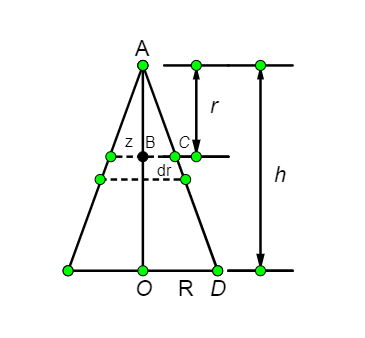Question
Question: Find the center of mass of a uniform solid cone....
Find the center of mass of a uniform solid cone.
Solution
The center of a solid body can be calculated by taking a suitable cross section in the body, applying it in the center of mass formula for continuous bodies and integrating it throughout to get the center of mass.
Complete answer:
In this question we are given a solid uniform cone of radius R and height h, we need to find the center of mass from the vertex. We need to use the below diagram to understand the problem.
Let us consider the radius of the base of the cone to be R and height is h.
We will consider a small circular cross section of radius ‘z’ and thickness ‘dr’ from a distance ‘r’ from the vertex of the solid cone.

Consider two triangles ABC and AOD. These triangles are similar triangles, so we can write,
AOAB=ODBC
This can be expressed as,
hr=Rz ……………… (1)
The volume of the small volume element considered is, dV=πz2dr, which can be written in terms of r from equation (1). So we get,
dV=h2πR2r2dr ……… (2)
Center of mass for continuous mass distribution is given by the formula,
C.M=M1∫rρh2πR2r2dr⟹C.M=Mh2πR2ρ∫r3dr
The limits of integration are from 0 to h, so
C.M=Mh2πR2ρ0∫hr3dr
.
On integrating and applying the limits we get,
C.M=4MπR2ρh2
Substituting M asM=ρV=3πR2hρ, we can write
C.M=43h
Note:
The distance of the center of mass from point O is 4h.
The center of mass of the cone will always lie on its axis due to symmetry.
The center of mass of a distribution of mass in space (sometimes referred to as the balance point) is the unique point where the weighted relative position of the distributed mass sums to zero. This is the point at which a force may be applied to cause a linear acceleration without an angular acceleration.
